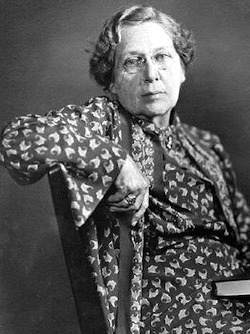Anna Williams

Anna Wessels Williams (1863-1954) was an American public health physician and bacteriologist.
Williams was a public health pioneer whose research shaped both laboratory science and the practice of preventive medicine. Working at the New York City Department of Health Laboratories during the bacteriological revolution, she became one of the first women physicians to hold a senior post in municipal medicine. Her work brought together clinical microbiology, epidemic control, and medical education at a time when public health was rapidly professionalizing.
Williams is best remembered for isolating a non-virulent strain of Corynebacterium diphtheriae in 1894, a discovery that enabled development of a diphtheria antitoxin that saved countless lives. With William H. Park (1863–1939), she co-authored the authoritative textbook Pathogenic Microorganisms (1905), which became a cornerstone for medical students and public health officers across the United States. She also introduced innovations in laboratory technique, including improved fixatives for diagnostic smears, that set new standards in teaching and routine practice.
Beyond the laboratory, Williams was a committed advocate for public health and women in medicine. She organised citywide trachoma control campaigns, coordinated laboratory responses during the 1918 influenza pandemic, and trained generations of physicians and health officers. By demonstrating that women could lead in medical science and public health policy, she helped open the profession to future generations. Her career stands as an example of science in the service of society, bridging laboratory precision with public health action.
Biographical Timeline
- 1863 – Born March 17 in Hackensack, New Jersey, into the family of a private-school teacher.
- 1883 – Graduated from the New Jersey State Normal School; worked as a teacher for two years.
- 1887 – Inspired to pursue medicine after witnessing her sister Millie’s traumatic stillbirth; enrolled at the Woman’s Medical College of the New York Infirmary.
- 1891 – Earned MD; interned at the New York Infirmary and remained as instructor in pathology and hygiene.
- 1892–1893 – Advanced medical training in Europe (Vienna, Heidelberg, Leipzig, Dresden).
- 1894 – Volunteered at the new diagnostic laboratory of the New York City Department of Health; isolated the Park-Williams No. 8 diphtheria bacillus, foundational for high-yield diphtheria antitoxin production.
- 1895 – Appointed bacteriologist at the NYC laboratory (first municipal diagnostic lab in the U.S.).
- 1896 – Researched scarlet fever antitoxin at the Pasteur Institute in Paris.
- 1898 – Created an effective rabies vaccine suitable for U.S. mass production.
- 1904–1905 – Identified abnormal brain cells in rabid animals concurrent with Adelchi Negri (1876-1912), an Italian pathologist at the University of Pavia. He published his seminal paper in 1904 and became widely recognized for the breakthrough.
- 1905 – Promoted to First Assistant Director of the NYC Health Department lab. Developed a rapid diagnostic staining method for rabies (Williams stain, 1905).
- 1914 – Published major study on trachoma in NYC schoolchildren.
- 1915 – President, Woman’s Medical Association.
- 1918 – Worked with William H. Park at Camp Upton during the influenza (H1 N1) pandemic; elected member of the American Association of Immunologists (AAI).
- 1921 – Published in Journal of Immunology on acute respiratory infections.
- 1929 – Co-authored Who’s who among the microbes, one of the first public-facing microbiology texts.
- 1932 – Became the first woman elected Chair of the Laboratory Section of the American Public Health Association.
- 1934 – Forced into retirement at age 71 under NYC’s mandatory retirement law, despite petitions of protest from colleagues.
- 1954 – Died November 20 in Westwood, New Jersey, aged 91.
Medical Eponyms
Park-Williams bacillus (1894)
Strain of Corynebacterium diphtheriae (PW8) isolated by Williams in 1894 from a mild case of tonsillar diphtheria which proved crucial to the development of a high yield anti-toxin for diphtheria.
William Park and colleagues Use PW8 to produce a highly potent antitoxin for diphtheria. Prior to Williams’s discovery, existing strains yielded only small quantities of toxin, limiting antitoxin production. The PW8 strain became the global standard for antitoxin manufacture, credited with saving countless children’s lives in the early 20th century.
A culture of the diphtheria bacillus, isolated by Dr. A. W. Williams, proved to be especially virulent, and the antitoxic serum prepared from it possessed a high degree of neutralizing power
Park and Williams, 1896
Williams stain (1905)
Diagnostic staining method for identifying Negri bodies in rabies
1903 – Adelchi Negri (1876-1912) described intracytoplasmic inclusions in rabies, later termed Negri bodies
1905 – Williams developed a rapid staining technique to identify “Negri bodies” and provide a reliable and timely diagnosis in public health laboratories. This became a standard test for rabies and test results were available within half an hour.
Within one year, the antitoxin was in mass production and public health departments were distributing it free of charge to physicians in the United States and Great Britain
By means of this stain, the characteristic bodies of rabies appear as sharply defined, deeply colored inclusions… the process requires but a few minutes and yields results of diagnostic certainty
Williams, 1905
Park-Williams fixative
Fixative solution devised by Williams and Park for preserving bacterial smears, widely adopted in public health laboratories in the early 20th century.
The Park-Williams fixative provided a stable and reproducible method for bacteriological preparations, ensuring accurate microscopic examination of pathogens in municipal diagnostic labs.
Public Health and Advocacy
Anna W. Williams was a public health leader who applied scientific discoveries directly to population health and was a vocal advocate for women in medicine.
Trachoma control:
At a time when trachoma was a leading cause of blindness in immigrant communities and schools, Williams conducted large-scale surveys and developed diagnostic techniques that allowed early detection. Her work shaped public health policy in New York City and helped limit the spread of the disease in institutional settings.
Influenza pandemic:
During the 1918 influenza pandemic, Williams coordinated testing and vaccination efforts at the New York City Department of Health. She directed staff to prepare and distribute hundreds of thousands of doses of an experimental bacterial vaccine. Though the true viral cause was not yet understood, her rapid mobilization illustrated the importance of laboratory-public health collaboration in crisis.
Advocacy for women in medicine:
As one of the first women physicians at the NYC Department of Health, Williams consistently promoted the role of women in medical science. She co-authored with William H. Park the influential Pathogenic Microorganisms (1905), which became a standard medical textbook for decades and helped normalize women’s names on major scientific works. She mentored young women entering medicine and often spoke publicly about the need for their participation in public health.
Major Publications
- Park WH, Williams AW. The production of diphtheria toxin. The journal of experimental medicine 1896; 1(1) [Park-Williams bacillus]
- Williams AW. Negri Bodies with Special Reference to Diagnosis. Proceedings of the New York Pathological Society. 1905; 5: 155-162 [Williams stain]
- Park WH, Williams AW. Pathogenic micro-organisms. 1905 [2e 1910] [11 editions by 1939]
- Williams AW. A Study of Trachoma and Allied Conditions in the Public School Children of New York City, The Journal of Infectious Diseases, 1914; 14(2): 261–337
- Williams AW et al. Studies on Acute Respiratory Infections. Journal of Immunology. 1921; 6(1): 5-24
- Park WH, Williams AW. Who’s who among the microbes. 1929
References
Biography
- Williams AW. Anna Wessels Williams Papers. Influenza Encyclopedia 1935; 22: 27-34
- Emrich JS. Anna Wessels Williams: Infectious Disease Pioneer and Public Health Advocate. 2012
Eponymous terms
- Negri A. Contributo allo studio dell’eziologia della rabbia. Bollettino della Società medico-chirurgica di Pavia, 1904; 2: 88–115.
- Bastian H. The First Century of Women in Vaccine Science: 1900-1930s (Part 1). PLOS 2021
- Swaby R. Trailblazers: 33 Women in Science Who Changed the World. 2017
- Dr Anna Wessels Williams. Changing the face of medicine. U.S. National Library of Medicine
Eponym
the person behind the name
MBBS, BSc (hons) Global and Public Health, Queen Mary University of London. Currently working as a Resident Medical Officer in Sir Charles Gairdner Hospital, Australia. Interests in Radiology, medical education and global public health.
BA MA (Oxon) MBChB (Edin) FACEM FFSEM. Emergency physician, Sir Charles Gairdner Hospital. Passion for rugby; medical history; medical education; and asynchronous learning #FOAMed evangelist. Co-founder and CTO of Life in the Fast lane | On Call: Principles and Protocol 4e| Eponyms | Books |

